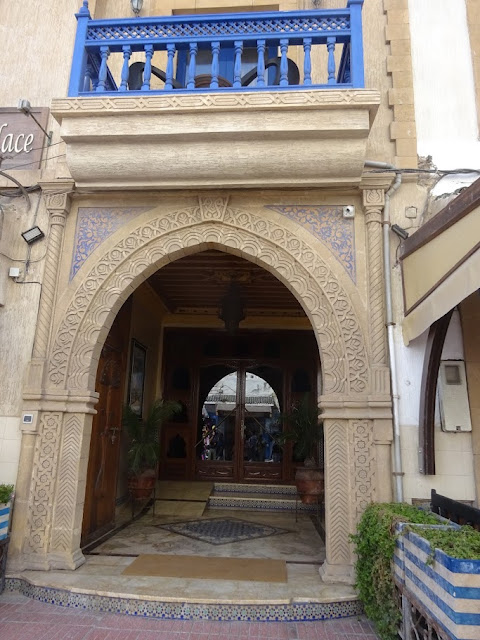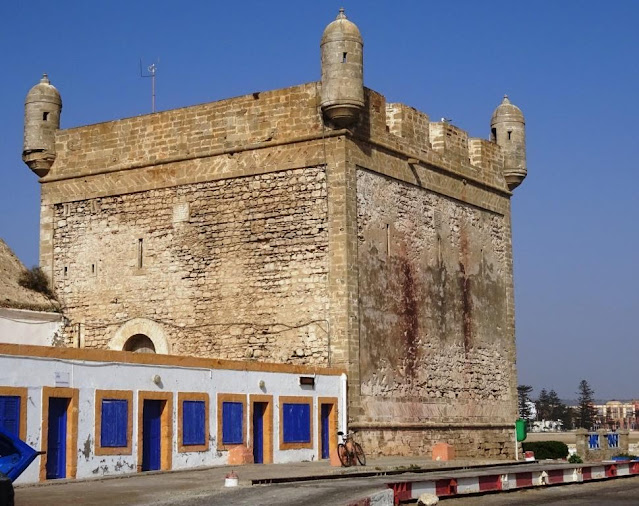
There are over 1 million people driving motorcycles and the manufacturing of automobiles is a big industry in Morocco.

While that may be the case in the cities, we continued to see many donkey carts in the rural areas transporting huge loads to and from the markets.

One town we went through must be the melon capital of Morocco! There were at least 100 trucks filled with watermelons and yellow melons similar to our honeydews.
Bamboo is also grown in this area of Morocco and they use it to make baskets, fences, and the conical shaped basket which is used as a cover over charcoal fires to dry clothes over.
There is a strong contrast between the irrigated fields and stretches of land without irrigation. In Morocco, water is the key to everything!

Before reaching Essaouira, we stopped to see the argan trees and Afous Argan, a women’s cooperative where they process the argan seeds.
Goats climb into the trees and eat the seeds if they are not careful. These goats, however, are part of a tourist stop. Locals have found that tourists love to take pictures of the goats in the trees, so you have to pay to take photos.


In order to extract the kernels, the argan fruits are first dried in the open air and then the fleshy pulp of the fruit is removed. At the cooperative, the next stage involves cracking the argan nut to obtain the argan kernels. Attempts to mechanize this process have been unsuccessful and therefore it is still carried out by hand, making it a time-consuming and labor-intensive process.




The kernels used to make argan oil for food use are roasted, then ground and pressed into bowls. Cosmetic oil is produced almost the same way, but the kernels are not roasted.


We had an opportunity to taste the pure argan oil, two types of argan flower honey, and one nutella- type peanut butter. They were all yummy! In their “showroom” we had a chance to also try the different lotions and cosmetic creams made with the argan oil.

Next to the cooperative was another cooperative shop where they had beautiful wooden boxes, trays, and tables made from the thulya tree which grows in this region. The tree is a hardwood similar to mahogany.


Essaouira is located at the foot of the Middle Atlas Mountains on the Atlantic Ocean. We had a chance to stop for a view of the city and ocean before our final descent into the city.

Essaouira was formerly known as Mogador. The modern name means "the little rampart", a reference to the Portuguese fortress walls that still enclose part of the city. The Portuguese occupied Essaouira in 1504 until about 1550.
After checking into our hotel, we had a walking tour of the medina. This is part of the walls into the medina.

Inside the medina, we again saw shops of every kind. Bread sellers with their carts, olives, chicken markets, spices, pottery, argan oil shops, and even modern electronics “shops”.



This was an entrance into a mosque where we saw people entering to pray.

This man was dressed in a djellaba, which is a traditional clothing for Berbers with the pointed hood.

Our guide, Abdulwahab, was standing by one of the old Portuguese cannons outside of the walls of the medina as he explained more about the history and culture of the city.

Tobey was happy to have his picture taken with this musician. There are several urban legends that Jimi Hendrix lived is Essaouira at one time or wrote music here. He visited here for 11 days in 1969 and left a lasting impression on the place!

Once outside of the medina, we had a small detour to reach the harbor area. We loved the sign!



This was the square before the gates leading to the ship yards and fish market area.

All of the boats are painted a nautical blue, not by mandate, but by choice.


Blue is everywhere – on the doors, the windows, the sky, the decorations, the details… Sometimes it’s a newly painted royal blue, sometimes it’s an Egyptian blue worn by time. Sometimes it is a bright turquoise that contrasts off the darker hues. Blue is Essaouira’s accent color that reminds you of the Atlantic Ocean lapping at the old fort walls. It gives the city a distinct personality that feels a little bit like Morocco and a little bit like Europe.
 After our tour, we went back to the hotel which is right across the street from the beach. Tobey, Wendy, and I went for a walk and saw windsurfers, kite surfers, and people offering camel rides on the beach.
After our tour, we went back to the hotel which is right across the street from the beach. Tobey, Wendy, and I went for a walk and saw windsurfers, kite surfers, and people offering camel rides on the beach.

 There was a “farewell” get together for drinks and snacks at sunset. Aside from it being VERY windy, it was lovely.
There was a “farewell” get together for drinks and snacks at sunset. Aside from it being VERY windy, it was lovely.

Eight of us walked a few blocks to a local restaurant where we had a seafood dinner before returning to the hotel around 9:30. The trip is quickly coming to a close, but we have seen many wonderful and amazing things!

All of the boats are painted a nautical blue, not by mandate, but by choice.


Blue is everywhere – on the doors, the windows, the sky, the decorations, the details… Sometimes it’s a newly painted royal blue, sometimes it’s an Egyptian blue worn by time. Sometimes it is a bright turquoise that contrasts off the darker hues. Blue is Essaouira’s accent color that reminds you of the Atlantic Ocean lapping at the old fort walls. It gives the city a distinct personality that feels a little bit like Morocco and a little bit like Europe.
 After our tour, we went back to the hotel which is right across the street from the beach. Tobey, Wendy, and I went for a walk and saw windsurfers, kite surfers, and people offering camel rides on the beach.
After our tour, we went back to the hotel which is right across the street from the beach. Tobey, Wendy, and I went for a walk and saw windsurfers, kite surfers, and people offering camel rides on the beach.
 There was a “farewell” get together for drinks and snacks at sunset. Aside from it being VERY windy, it was lovely.
There was a “farewell” get together for drinks and snacks at sunset. Aside from it being VERY windy, it was lovely. 
Eight of us walked a few blocks to a local restaurant where we had a seafood dinner before returning to the hotel around 9:30. The trip is quickly coming to a close, but we have seen many wonderful and amazing things!

No comments:
Post a Comment